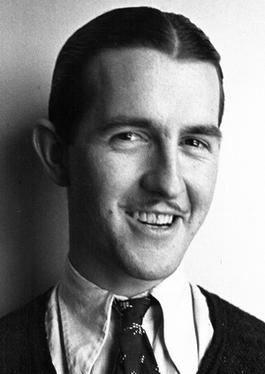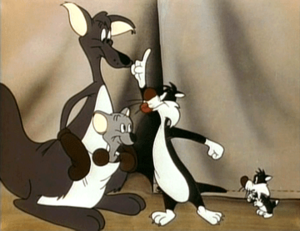Robert McKimson facts for kids
Quick facts for kids
Robert McKimson
|
|
|---|---|

Robert McKimson, early 1930s
|
|
| Born |
Robert Porter McKimson
October 13, 1910 Denver, Colorado, U.S.
|
| Died | September 29, 1977 (aged 66) Burbank, California, U.S.
|
| Other names | Bob McKimson Buck McKimson |
| Occupation | Animator, illustrator, director |
| Years active | 1929–1977 |
| Employer | Walt Disney Productions (1929–1930) Romer Grey Studio (1930) Harman and Ising (1930–1933) Warner Bros. Cartoons (1933–1963) Cascade Studios (1953) DePatie-Freleng Enterprises (1963–1968; 1972–1977) Warner Bros.-Seven Arts (1968–1969) |
| Spouse(s) | Viola McKimson (d. 1963) |
| Children | 2 |
Robert Porter McKimson Sr. (born October 13, 1910 – died September 29, 1977) was a talented American animator and illustrator. He is most famous for his amazing work on the Looney Tunes and Merrie Melodies cartoons. These popular cartoons were made by Warner Bros. Cartoons and later by DePatie–Freleng Enterprises.
McKimson wrote and directed many cartoon shorts. He worked with beloved characters like Bugs Bunny, Daffy Duck, Porky Pig, Foghorn Leghorn, Hippety Hopper, Speedy Gonzales, and the Tasmanian Devil. He also helped create Bugs Bunny's look in the 1943 cartoon Tortoise Wins by a Hare.
Contents
Robert McKimson's Animation Journey
Early Life and Artistic Beginnings
Robert McKimson was born in Denver, Colorado, on October 13, 1910. His family moved around a lot, living in places like Wray, Colorado, and Canadian, Texas. They finally settled in Los Angeles in 1926.
From 1927 to 1928, Robert and his brother Tom worked on a children's book. Their mother wrote the book, called Mouse Tales. The characters in it looked a lot like those in Walt Disney cartoons, such as Mickey Mouse. These drawings were stored away for many years before being found again.
Starting at Disney and Other Studios
In mid-1929, Robert got a job at Walt Disney Studio. He worked as an assistant animator for Dick Lundy. His brother Tom also started working there. The studio was small, with less than 30 people.
After three months, the brothers got a pay raise. In 1930, they were offered more money to work at a new studio. This studio was started by Romer Grey, the son of a famous writer. The Romer Grey Studio made a few cartoons, including some with a character called Binko the Bear Cub. These cartoons also looked a lot like Mickey Mouse. However, because of the Great Depression, the studio could not release its cartoons.
Joining Warner Bros. Cartoons
While working for Grey, McKimson also started at Harman and Ising. He began by doing ink-and-paint work for the first Looney Tunes cartoons. He then became an in-betweener before becoming a full animator by 1931. Around this time, he had an accident that gave him a concussion. This injury actually helped him visualize things better, which improved his animation work.
By the late 1930s, he was a lead animator at the studio. He worked closely with Bob Clampett. In 1938, he was offered a chance to direct cartoons, but he turned it down. Instead, Chuck Jones became a director. McKimson finally accepted a directing job in late 1944. This happened when Frank Tashlin left Warner Bros. to direct live-action movies.
McKimson's first cartoon for Warner Bros. was The Return of Mr. Hook, released in 1945 for the U.S. Navy. His first cartoon shown in theaters was Daffy Doodles in April 1946. His third theatrical cartoon, Acrobatty Bunny, was his first Bugs Bunny short as a director. It came out in June 1946. Some of his well-known cartoons include Hillbilly Hare, A-Lad-In His Lamp, Stupor Duck, The Windblown Hare, Walky Talky Hawky, and Big Top Bunny.
McKimson created famous characters like Foghorn Leghorn and the Tasmanian Devil. He also directed all the cartoons featuring Hippety Hopper and Sylvester. He created Speedy Gonzales for the 1953 cartoon Cat-Tails for Two. He continued to direct many Speedy Gonzales cartoons throughout his career.
Changes at Warner Bros.
In June 1953, the Warner Bros. cartoon studio closed for six months. This was because of a new trend called 3-D movies, which the studio found too expensive for cartoons. McKimson's animation team was even shut down earlier. He made a commercial during this time.
When the studio reopened, other directors quickly got their teams back. McKimson had to work hard to convince Warner Bros. to reopen his team. He had to accept lower pay for his unit. He couldn't hire back many of his old animators, including his brother Charles. For a short time, McKimson even animated some of his own cartoons, like The Hole Idea. Soon, he built a new team of artists. McKimson's office at the Warner Bros. studio was on the second floor.
Later Career and Final Years
Working Through Studio Changes
McKimson kept working at Warner Bros. as the studio started to lose staff in the early 1960s. His son said that Robert wasn't happy with how things were going. He missed the older style of animation and didn't like some of the new characters. During this time, he directed many shorts and worked on the movie The Incredible Mr. Limpet.
After the studio closed, he joined DePatie–Freleng Enterprises. This company was co-owned by his old friend Friz Freleng. At DePatie–Freleng, McKimson directed some The Inspector cartoons. He also worked on Looney Tunes and Merrie Melodies cartoons that Warner Bros. hired them to make.
In 1967, Warner Bros. opened its animation studio again. McKimson rejoined the studio in 1968. His son said that Robert didn't enjoy the cartoons he directed at this time. They had smaller budgets, and he wasn't allowed to use Bugs Bunny. The studio closed again in 1969. His last Warner Bros. cartoon was Injun Trouble with Cool Cat. It was considered for an Academy Award. This cartoon was also the last original Looney Tunes or Merrie Melodies cartoon made before the studio closed. McKimson was the only person who worked at the studio from the very beginning of the Looney Tunes series until its end in 1969.
After a break, he returned to DePatie–Freleng in 1972. There, he directed cartoons for The Pink Panther Show and other series.
Death and Legacy
On September 27, 1977, McKimson's doctor said he was in good health for his age. However, on September 29, McKimson had a sudden heart attack and passed away at age 66. At the time, he had just finished directing Misterjaw and started working on Baggy Pants and the Nitwits.
Robert McKimson was buried at Forest Lawn Cemetery in Glendale, California.
Personal Life
McKimson's wife, Viola, passed away in 1963. Besides being a great animator, McKimson was also a skilled horseman and played polo. He was a dedicated bowler and a Master Mason. He played polo from 1932 until 1942. His two sisters, Anabel and Aylce McKimson, also worked as animators. His brother Charles often worked on Robert's team at Warner Bros.


